Only that man who has offered up himself entire to the blood of war, who has been to the floor of the pit and seen horror in the round and learned at last that it speaks to his inmost heart, only that man can dance. (Blood Meridian’s Judge Holden)
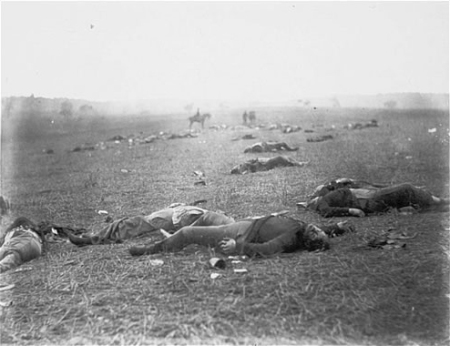
Preliminary Notes:
Taking to heart the French statesman George Clemenceau’s – whose terms to Germany after World War I was a contributing factor to the advent of the second – famous line that “war is a much too serious matter to be entrusted to the military”, I thought a rundown of how war has been presented on film could fit the bill. I will focus on films made after the silent era and mostly western films. For this first part of the article, I’ll concentrate on films made before 1980, as more recent films are generally better known, and as I opine, perhaps hazardly, that the modern War Film starts with Samuel Fuller’s The Big Red One from 1980. Even though war is eternal, I’ll not discuss conflicts prior to the American civil war. Naturally, I will dedicate more lines to some films than others. I’ll try to only include more or less worthwhile films, so there will be no further mention of, say, A Farewell to Arms in any of its movie incarnations (read the book instead!). I’ll deal with them as they pop up in my mind, so don’t expect a strictly linear account!

What is a war film? I think the genre can be divided into at least 5 sub-genres:
1-The Soldier’s War (These films should feature battles or at least mostly stay with the soldiers on and off the battle field.)
2-The /Leaders’/Generals’ war (These also normally include battles, but are more concerned with the machinations and tactics and are often indicative of History’s hindsight and received wisdom concerning the outcome).
3-The POW-film ( Prisoners of war).
4-The Home Front-film (Films relating the situation and state of morale away from the intense battles. These films can deal with the local resistance, with war-profiteering, with acts of collusion, etc. Often they are about everyday-people and how they “do their part”)
5-The Agent/Spy-film (This can at times overlap with all of the above, especially number 4).
All of these subgenres can have subgenres of their own: The Soldier’s War can be a submarine-film, for example, with all that entails of regular features such as the beeping radar and having to dive deeper than the hull can theoretically stand, claustrophobia, etc. It can also be a boot camp film, but most of these see action in the second half (Full Metal Jacket,1987, being an obvious modern example). I think that for most, the term War Film denotes soldiers fighting enemy soldiers in some way or another. Thus, I consider the first two subgenres I mentioned the only kind of “pure” war films. I’ll try to focus on these, but will mention other types as well.
Usually war films can also be separated by difference of intent; what is the purpose of the film? I think it is possible to separate between the Serious War Film and War As Entertainment. Of course, most films have a bit of both, but the weight tends to fall solidly down on one of the sides. In the latter case, war is often tangential, an excuse for blowing up things and tell an exciting story; almost what Hitchcock referred to as a MacGuffin; Kelly’s Heroes is an example, maybe also Casablanca. This doesn’t make them less worthy as films; it is not unusual for films like this to be better than the often propagandistic and preaching serious film. A rule of thumb is that the closer in time the film is to the conflict it portrays, the more likely is an overt element of propaganda. Then also, one has films that take place in a war situation – particularly films that were made during the war – but has little interest in the war itself except as a setting and a time for the story; Preston Sturges’ comedies Hail the Conquering Hero and Miracle at Morgan’s Creek (both 1944) are examples. They both feature soldiers aplenty and talk about the protagonists’ wishes to enlist, but neither film could care less about the war.
1-Lewis Milestone
One can’t well escape the name Lewis Milestone while talking of war films. He made All Quiet on the Western Front as early as in 1930. William Wellman had made Wings in 1927, also dealing with world war I, but Milestone’s classic was not only the first sound film on the subject, but one of the best ever. It holds up surprisingly well today, with the action scenes having a much more authentic feel to them than anything cooked up well into the 1990s. It is definitely on my top ten list of the best war films ever made.
 Milestone went on to make some more near-classics in the genre. I really like Pork Chop Hill (1959), about a true incident toward the end of the Korean war, with Gregory Peck as the stolid squad leader. It tackles the absurdness of having to defend a hill that has little – if any – strategic value. The soldiers are put in the war zone merely for reasons of allowing the time for political back room manoeuvres. Interspersed with the intense fighting, we catch glimpses of this other kind of war, where the participants risk nothing but lack of prestige. After having ploughed through at least a hundred war films, I’ve come to realize that most good films of this type are in fact anti-war films, and many pointing out the surreal aspect of war’s existence, which is hardly that difficult to do (see, or rather, don’t, Catch 22 or especially Mash – one of my least favourite films! – for the laughably evident and clichéd take on this subject). Pork Chop Hill is in the tradition of the antiwar-film, but as with his 1930 masterwork, Milestone manages to imbue the battle scenes with a sense of reality uncommon for the time the film was made, and the dilemmas and situations seem real to a degree that puts most Hollywood films to shame.
Milestone went on to make some more near-classics in the genre. I really like Pork Chop Hill (1959), about a true incident toward the end of the Korean war, with Gregory Peck as the stolid squad leader. It tackles the absurdness of having to defend a hill that has little – if any – strategic value. The soldiers are put in the war zone merely for reasons of allowing the time for political back room manoeuvres. Interspersed with the intense fighting, we catch glimpses of this other kind of war, where the participants risk nothing but lack of prestige. After having ploughed through at least a hundred war films, I’ve come to realize that most good films of this type are in fact anti-war films, and many pointing out the surreal aspect of war’s existence, which is hardly that difficult to do (see, or rather, don’t, Catch 22 or especially Mash – one of my least favourite films! – for the laughably evident and clichéd take on this subject). Pork Chop Hill is in the tradition of the antiwar-film, but as with his 1930 masterwork, Milestone manages to imbue the battle scenes with a sense of reality uncommon for the time the film was made, and the dilemmas and situations seem real to a degree that puts most Hollywood films to shame.
In between his films of the First World War and the Korean war, Milestone also made a film about the battles of the pacific, Halls of Montezuma (1951), with the ever dependable Richard Widmark, and one about the 1943 invasion of Italy: A Walk in the Sun. This is considered to be maybe the first film that captured the experience and everyday worries of the soldiers in a realistic way. I have not seen the latter due to it being impossible to find in a satisfying DVD release, but Halls…, while solid and containing some classic scenes and dilemmas, is not quite up to the level of these other films. Milestone made a bunch of other war films (I have a bit of faith in The Purple Heart, which I will see soon), but while most of these receive passable reviews, I have not yet seen them and can’t comment on their respective qualities.
Other good early war films include Jean Renoir’s WWI POW-drama La Grande Illusion (1937) and Michael Curtiz’ Charge of the Light Brigade (1936), one of the few films about the Crimean War, though not all that historically trustworthy. I’d like to see Howard Hawks’ The Road to Glory (1936) about WWI trench warfare and with a script by William Faulkner, but haven’t yet had the opportunity.
2-John Huston and Documentaries
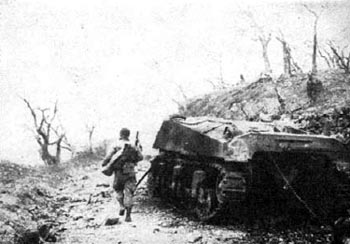 During World War II, many of Hollywood’s directors were made officers and sent out to shoot real documentary footage of the war. John Ford (Who made the Oscar winning documentary The Battle of Midway, not to be confused with the later motion picture of the same name), Frank Capra, George Stevens and William Wyler all made excellent reportage-films that mostly managed to elevate themselves from base propaganda. John Huston made some films in this way that today are considered classics, independently of which context they were made in (Battle of San Pietro, Let There Be Light). Most of the films he shot had to go through the military for approval, and as a consequence were heavily edited, or classified and only recently being shown to the general public. The men in power felt that Huston showed a side of the war the public were better off not knowing about. This included attempts to humanize the enemy, show less than wholesome examples of American soldiers and their behaviour in the war and examine the psychical scars of the soldiers.
During World War II, many of Hollywood’s directors were made officers and sent out to shoot real documentary footage of the war. John Ford (Who made the Oscar winning documentary The Battle of Midway, not to be confused with the later motion picture of the same name), Frank Capra, George Stevens and William Wyler all made excellent reportage-films that mostly managed to elevate themselves from base propaganda. John Huston made some films in this way that today are considered classics, independently of which context they were made in (Battle of San Pietro, Let There Be Light). Most of the films he shot had to go through the military for approval, and as a consequence were heavily edited, or classified and only recently being shown to the general public. The men in power felt that Huston showed a side of the war the public were better off not knowing about. This included attempts to humanize the enemy, show less than wholesome examples of American soldiers and their behaviour in the war and examine the psychical scars of the soldiers.
Of course, Huston later went on to make some of the best films of the 20th. century – The Treasure of the Sierra Madre, The Asphalt Jungle, Key Largo, The Man Who Would be King. He had early on tried his hand at handling the war in a less serious way in Across the Pacific (1942), which was fatally cut without his presence, as he was on a boat on the way to the real war. Then he had more luck with the wonderful war drama Heaven Knows, Mr. Allison (1957), starring Robert Mitchum and Deborah Kerr. This could almost have been a play between the two persons, as they are alone on the screen for 90% of the film. However, when the Japanese land on the island that our protagonists find themselves marooned on, the film becomes genuinely exciting and it avoids falling into the usual traps of cliché and contrivance. I like it a lot!
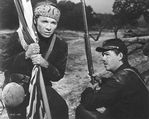 Huston made a final attempt to handle the war theme in the ludicrous Escape to Victory when he was well past his powers as a filmmaker. While this film didn’t pave his way into Director’s Heaven, the road was already neatly laid, as he made The Red Badge of Courage (1951). It is about the American Civil War, and is among the all time greats of war films. Huston’s original cut was probably about 30 minutes longer than the 69 minutes of the theatrical release. The studio made the cuts while Huston was in Africa to shoot The African Queen (which I could have included here, since it’s set in WWI, but I feel it is more of a romance than a war film. It is, though, very good!). They based their vandalism on preview screenings in which scenes of cowardice had angered the test audience. Maybe the Generals had been right in censoring Huston’s earlier war documentaries, as the audience evidently preferred the sanitized version? It says something about Huston’s understanding of war that the film is so good still in its butchered version. (Mind, The Red Badge of Courage is probably not for everyone. Huston uses on purpose an archaic way of storytelling, and this might in effect be estranging for some). It is one of my film historical dreams that the lost material will one day resurface, but I think the chances are slim.
Huston made a final attempt to handle the war theme in the ludicrous Escape to Victory when he was well past his powers as a filmmaker. While this film didn’t pave his way into Director’s Heaven, the road was already neatly laid, as he made The Red Badge of Courage (1951). It is about the American Civil War, and is among the all time greats of war films. Huston’s original cut was probably about 30 minutes longer than the 69 minutes of the theatrical release. The studio made the cuts while Huston was in Africa to shoot The African Queen (which I could have included here, since it’s set in WWI, but I feel it is more of a romance than a war film. It is, though, very good!). They based their vandalism on preview screenings in which scenes of cowardice had angered the test audience. Maybe the Generals had been right in censoring Huston’s earlier war documentaries, as the audience evidently preferred the sanitized version? It says something about Huston’s understanding of war that the film is so good still in its butchered version. (Mind, The Red Badge of Courage is probably not for everyone. Huston uses on purpose an archaic way of storytelling, and this might in effect be estranging for some). It is one of my film historical dreams that the lost material will one day resurface, but I think the chances are slim.
3-The Europeans during the War
The British were perhaps more accommodating to letting reality creep into their fictions. David Lean’s In Which We Serve, a study about the personnel of a navy ship told in flashbacks as the survivors of a German attack clings to a raft, is notable for drawing a rounded picture of the men and their backgrounds, and as such bringing questions of class and position in society into the mix. It is at times sentimental, but it is more often true. Carol Reed’s The Way Ahead (1944) begins as a typical propaganda film about the importance of “doing one’s part”, but the film seems to grow and, because of the talent at hand, go beyond what one should expect from a film of this genre. It is one of the best “training” films I have seen, adding a pathos and realism to the boot camp-scenes that impressed me.
Michael Powell and Emeric Pressburger’s The Life And Death of Colonel Blimp is something as seldom as a genuinely intelligent and reflective film about the concept of war – and the men who make war – made during the war (It was released in the UK in 1943, but not until May 1945 did it premiere in USA). They also made the solid One of our Aircraft is Missing (1942), about a real case involving the Dutch resistance, and 49th Parallel (1941), which I haven’t seen yet, so I can’t comment upon its merits. I will say, though, that I have not yet seen a bad film from Powell and Pressburger, and at least five of their films are in my top 200 list (Colonel Blimp, A Matter of Life and Death, which is also a war film of sorts and quite wonderful, I Know Where I’m Going, A Canterbury Tale, Black Narcissus, and The Red Shoes are all genuine classics).
 Alfred Hitchcock made Saboteur (1942) and Foreign Correspondent (1940), both of these are about spies/foreign agents and both well inside the War as Entertainment – and propaganda – category. – And entertaining they are! They are technically American films, and Foreign Correspondent ends with a passionate plea to the Americans to enter the war. He made a more “serious entertainment” in 1944, taking on John Steinbeck’s propagandist script about a group of survivors in the eponymous Lifeboat. It’s wonderful to see how the master manages to keep the camerashots of the film interesting and maintain a constant tension in such a limited set as a lifeboat.
Alfred Hitchcock made Saboteur (1942) and Foreign Correspondent (1940), both of these are about spies/foreign agents and both well inside the War as Entertainment – and propaganda – category. – And entertaining they are! They are technically American films, and Foreign Correspondent ends with a passionate plea to the Americans to enter the war. He made a more “serious entertainment” in 1944, taking on John Steinbeck’s propagandist script about a group of survivors in the eponymous Lifeboat. It’s wonderful to see how the master manages to keep the camerashots of the film interesting and maintain a constant tension in such a limited set as a lifeboat.
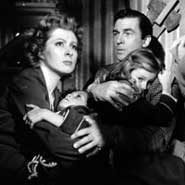 One of the biggest film successes coming out of the war was William Wyler’s Mrs. Miniver, about an upper middle class family and their tribulations during the blitz in England. It won lots of Oscars and even spurred a sequel, The Miniver Story, which is not particularly worthwhile. The original has been a bit of a pet peeve among modern critics, thinking it dated and anachronistic in its portrayal of the class system (rich people are really kind if you just talk nicely to them!). I think it holds up well, even though the first scene, where Mrs. Miniver just HAS to buy a birdlike hat, is a bit beyond the pale. Wyler’s direction is so good that the possible unfortunate political ramifications take a back seat to the “common spirit of the English” and some wonderful scenes of the family finding strength in each other, even winning over to their side a goddamn sentimental commie like myself. And Teresa Wright has never done a bad film as far as I’m concerned.
One of the biggest film successes coming out of the war was William Wyler’s Mrs. Miniver, about an upper middle class family and their tribulations during the blitz in England. It won lots of Oscars and even spurred a sequel, The Miniver Story, which is not particularly worthwhile. The original has been a bit of a pet peeve among modern critics, thinking it dated and anachronistic in its portrayal of the class system (rich people are really kind if you just talk nicely to them!). I think it holds up well, even though the first scene, where Mrs. Miniver just HAS to buy a birdlike hat, is a bit beyond the pale. Wyler’s direction is so good that the possible unfortunate political ramifications take a back seat to the “common spirit of the English” and some wonderful scenes of the family finding strength in each other, even winning over to their side a goddamn sentimental commie like myself. And Teresa Wright has never done a bad film as far as I’m concerned.
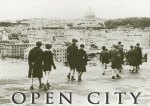 In Italy, Roberto Rossellini’s Rome, Open City kick started the Italian Neo-Realism. It was made while Rome was in ruins and the war almost not ended yet, and – as the movement’s name indicates – is indeed more realistic than its Hollywood counterpart in dealing with the people that fight a war, even though they fight invisibly and die unknown. Better than most films, it shows that you’ll find allies as well as enemies in unlikely places. Many of the featured “actors” had been in the resistance until days before shooting. There are scenes in this film that stay in your memory.
In Italy, Roberto Rossellini’s Rome, Open City kick started the Italian Neo-Realism. It was made while Rome was in ruins and the war almost not ended yet, and – as the movement’s name indicates – is indeed more realistic than its Hollywood counterpart in dealing with the people that fight a war, even though they fight invisibly and die unknown. Better than most films, it shows that you’ll find allies as well as enemies in unlikely places. Many of the featured “actors” had been in the resistance until days before shooting. There are scenes in this film that stay in your memory.
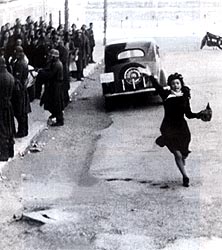 I’ll take the opportunity, while writing about Europe and the Resistance, to mention one of my all time favourites of the “resistance-genre”, even though it’s made much later (1969): Army in the Shadows (L’Armée des Ombres). This is a must-see for anyone interested in the subject. The director, Jean Pierre Melville, is definitely among my three favourite Frog-helmers. While I enjoy immensely Le Samourai (1967) with Alain Delon, I think this is his best film. (Mind, I’ve not seen Le Doulos yet…). As I have just seen La Silence de la Mer, made by people fighting for the resistance (Melville was a French jew) and based on an important novel of war time France, I simply must mention here how much I liked it. It is by no means an action approach to resistance work, rather dealing with ideas of nationality and personality; what does an occupation force want, and how can one repel it? It talks of the history of one country in consequence wanting to erase the history of another. It is a film that manages to be very literary (with voice-overs and long one-way dialogues that must not be mistaken for monologues, as that would go contrary to the film’s meaning) and very filmatic at the same time. It is enough to see how the dialogue is finally executed, the promise of a reply finally fulfilled, by the leaving open of a book by Anatole France. The following reaction shot zooms in on the messenger with a force that left me shaken and stirred, and is an example of the power of film, of moving images. The film is shot in a way to make it look older than it is, thereby accentuating the historic (history of cultures) and eternal aspect of the story’s ideas.
I’ll take the opportunity, while writing about Europe and the Resistance, to mention one of my all time favourites of the “resistance-genre”, even though it’s made much later (1969): Army in the Shadows (L’Armée des Ombres). This is a must-see for anyone interested in the subject. The director, Jean Pierre Melville, is definitely among my three favourite Frog-helmers. While I enjoy immensely Le Samourai (1967) with Alain Delon, I think this is his best film. (Mind, I’ve not seen Le Doulos yet…). As I have just seen La Silence de la Mer, made by people fighting for the resistance (Melville was a French jew) and based on an important novel of war time France, I simply must mention here how much I liked it. It is by no means an action approach to resistance work, rather dealing with ideas of nationality and personality; what does an occupation force want, and how can one repel it? It talks of the history of one country in consequence wanting to erase the history of another. It is a film that manages to be very literary (with voice-overs and long one-way dialogues that must not be mistaken for monologues, as that would go contrary to the film’s meaning) and very filmatic at the same time. It is enough to see how the dialogue is finally executed, the promise of a reply finally fulfilled, by the leaving open of a book by Anatole France. The following reaction shot zooms in on the messenger with a force that left me shaken and stirred, and is an example of the power of film, of moving images. The film is shot in a way to make it look older than it is, thereby accentuating the historic (history of cultures) and eternal aspect of the story’s ideas.
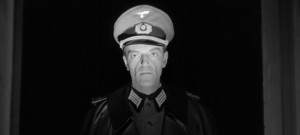
Honourable mention, while discussing resistance films, must also go to Paul Verhoeven’s rascally 2006-film Black Book (Zwartboek) as well as the same director’s Soldaat van Oranje (1977). I did not think so highly of Gillian Armstrong’s Charlotte Gray (2001), which was more of a pure entertainment and not more than passable at that. And finally, let me not forget to mention the Norwegian classic Ni Liv (Nine Lives) by Arne Skouen. It was well deservedly nominated for an Oscar in 1958 and, while maybe a bit dated, is of a higher class both in terms of realism and art than most other Scandinavian films of that or any time.
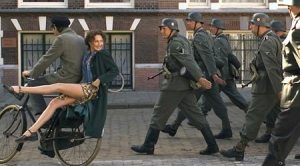
Let me finally add here that I know there are many Eastern European, in particular Russian, films from the 50s and 60s that would warrant an inclusion here, but as I’m not yet familiar with these, I’ll leave them for another occasion or a future post. I’ve read good things about the Rumanian film Mihai Viteazul (Last Crusade) (1970), which is about a war before the timeframe I’ve chosen for this article, and Roman Polanski’s old mentor Andrzej Wajda made a famous trilogy that I’ve not yet seen, with films like Kanal and Ashes and Diamonds, about the Polish war experience. As for Asian films, I’ll try to include them in a separate post, as this article seems to be long enough as it is…
4- Hollywood During the War
Not all film-makers were documentarists during the war. Hollywood also made more traditional war films. The best of the more or less realistic Hollywood films was probably The Story of G.I. Joe by William Wellman. However, Hollywood’s role was foremost to do what it does best: make entertainments. I have mentioned Casablanca (1942), which everyone knows. Michael Curtiz’ unexpected hit spurred a number of copies, one time even with the same director, most of the actors and a similar story; Passage to Marseille (Michael Curtiz, 1944). Bogart also played in Zoltan Korda’s Sahara, about some Americans and British troops that must join forces to stave off the thirsty German battalion that wants their water supply. Sahara is solid entertainment but not great. Howard Hawks’ To Have and Have Not (1944), again with Bogart, is in the same vein as Casablanca. It is very entertaining, with a script so full of one-liners it could put modern Hollywood to painful shame, and a fantastic film, but I feel it is stretching it a bit to call it a war film.
Some films chose a middle ground by portraying the war in a pseudo-documentary fashion and adding contrived traditional plots: Guadalcanal Diary (1943) about battles of the Solomon Islands in the Pacific and Wake Island (1942) (also about the Pacific) both starr William Bendix. The latter film is directed by John Farrow, who has made some wonderful Film Noirs. I have only seen excerpts of these films, but a general impression is that the scripts seem weak but the fighting real. This can partly be explained by the use of stock footage, but also by the participation – quite literally – of the US-army (and especially the US Marine).
Then there was John Wayne, who didn’t volunteer for service, partly because he wanted to capitalize on his new found fame in John Ford’s Stagecoach. While he didn’t really make any noteworthy films during the war years, when John Ford came back from the war, they made They Were Expendable together in 1945, about a group of Patrol Torpedo boaters in the Philippines, and that is a bit of all right. There are some impressive battle scenes (between boats and planes, between land based batteries and the boats) and a strangely “un-Hollywoodish” air over the plot: The hero doesn’t get the girl, the film ends in seemingly defeat, with the last caption saying “We’ll be back!” This feels a bit odd, considering it’s about events in 1942-43 and the film is from 1945. The defeat at the end of the film is also the subject of Tay Garnett’s Bataan (1943), with Robert Taylor as the tough sergeant famously yelling “come and get it suckers!” to the Japanese attackers. Bataan was evidently MGM’s answer to Paramount’s Wake Island, by the way. This film also ends with a declaration intended to give hope: “Their spirit will lead us back to Bataan.” It’s a bit ironic that the film could almost be a remake of John Ford’s 1934 film The Lost Patrol, about a group of WWI soldiers fighting off Arabs. Ford’s film was again a remake of a 1929-version of the film, and the already mentioned Sahara is a remake of sorts of both of them.
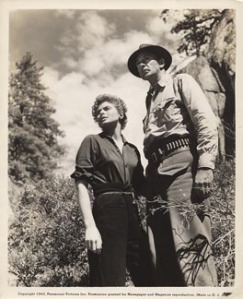 Sam Wood’s film of Ernest Hemingway’s For Whom the Bell Tolls – about the Spanish civil war – is marred by the director’s/studio’s insistence on not calling the rightwing Francoists “fascist” and Gary Cooper’s guerrillas “communist”. Sam Wood was, by the way, a staunch supporter for McCarthy and his Hollywood witch hunts (The Commie Scare), so I don’t think he was quite the right man for the task. As John Huston writes in his autobiography, An Open Book, Sam Wood was a rabid anti-communist and made a will on his death bed where he stated that his daughter would inherit everything, providing she didn’t prove to be a communist. Lewis Milestone, incidentally, conveyed to Huston that he was somewhat distressed that Wood had threatened to expose him as a commie. Apart from the film being less than what it could have been, it is still a grand entertainment and Ingrid Bergman is as always lovely.
Sam Wood’s film of Ernest Hemingway’s For Whom the Bell Tolls – about the Spanish civil war – is marred by the director’s/studio’s insistence on not calling the rightwing Francoists “fascist” and Gary Cooper’s guerrillas “communist”. Sam Wood was, by the way, a staunch supporter for McCarthy and his Hollywood witch hunts (The Commie Scare), so I don’t think he was quite the right man for the task. As John Huston writes in his autobiography, An Open Book, Sam Wood was a rabid anti-communist and made a will on his death bed where he stated that his daughter would inherit everything, providing she didn’t prove to be a communist. Lewis Milestone, incidentally, conveyed to Huston that he was somewhat distressed that Wood had threatened to expose him as a commie. Apart from the film being less than what it could have been, it is still a grand entertainment and Ingrid Bergman is as always lovely.
Neither must one forget Howard Hawks’ Sergeant York (1941), which – although concerning WWI – was promoting general US patriotism and made the country ready for another war, so to say. And, talking about propaganda, who can forget Michael Curtiz’ splendid, though enormously jingoistic, semi-musical, Yankee Doodle Dandy (1942), with James Cagney in an eye opening and brilliant performance? Man, that man can dance! Let me at last give a shout out for veteran director Raul Walsh’s Objective Burma! (1945), which has an entertaining story and impressive fight scenes, good enough to outdo most films made 20 or 30 years later.
5-Hollywood After the War

After World War II ended, there came a batch of films trying to show the people back home how the war had been for the soldiers fighting it. The best film dealing with the homecoming experience itself must be William Wyler’s The Best Years of Our Lives, which is one of my favourite films, period. It has all the elements that The Studio System at its best and most adventurous could deliver; an ensemble cast of great, great actors and actresses, a story that seems not only important but right to tell, feeling much more real than Hollywood’s recent batch of issue-films. Crash (2004), for example, looks inane in its political correctness in comparison. And I don’t think Oliver Stone’s Born on the Fourth of July (1989) holds a candle to the experience of a soldier’s return in Wyler’s masterwork. The closest in quality I have seen of dealing with the immediate post war experience is a quite different sort of film, focusing on the rebuilding of Berlin and the consequences of the American presence there: Billy Wilder’s A Foreign Affair (1948). It is at times a comedy, but the comedy is dark and mostly it is a very impressive contemporary take on the German’s situation. (For a pure comedic version, one can see Wilder’s later One, Two, Three (1961), which deals with the cold war and the divided Germany, and manages to be a savage criticism about both Capitalism and Communism while still being very funny. It’s hardly a war film, though!).
 I also think that without Fred Zinneman’s The Men (1950), Oliver Stone would have a few war films less on his resumé. – And, speaking of Zinneman, let’s not forget his classic army base film, From Here to Eternity, based on James Jones’ brilliant first novel about military life and death – and some reflections about the injustices of the military as an institution – just prior to the Japanese attack on Pearl Harbor. Many think of the film as a kind of romantic drama, a notion probably aided by the famous beach scene with Burt Lancaster and Deborah Kerr, which is one of the enduring images of the 20th century. Make no mistake about it, though, this film portrays a man’s world, which makes both the men’s and women’s lot in the film far removed from any chances of lasting happiness outside the rush of war. For a continuation of the action started in this film, see for example Otto Preminger’s In Harm’s Way, that I’ve written about in an earlier post, or Richard Fleischer/Kinji Fukasaku’s Tora! Tora! Tora! (Fukasaku took over the Japanese sections of the film after Akira Kurosawa got disillusioned about the production. Fukasaku’s last film was, by the way, the youth/media war satire Battle Royale).
I also think that without Fred Zinneman’s The Men (1950), Oliver Stone would have a few war films less on his resumé. – And, speaking of Zinneman, let’s not forget his classic army base film, From Here to Eternity, based on James Jones’ brilliant first novel about military life and death – and some reflections about the injustices of the military as an institution – just prior to the Japanese attack on Pearl Harbor. Many think of the film as a kind of romantic drama, a notion probably aided by the famous beach scene with Burt Lancaster and Deborah Kerr, which is one of the enduring images of the 20th century. Make no mistake about it, though, this film portrays a man’s world, which makes both the men’s and women’s lot in the film far removed from any chances of lasting happiness outside the rush of war. For a continuation of the action started in this film, see for example Otto Preminger’s In Harm’s Way, that I’ve written about in an earlier post, or Richard Fleischer/Kinji Fukasaku’s Tora! Tora! Tora! (Fukasaku took over the Japanese sections of the film after Akira Kurosawa got disillusioned about the production. Fukasaku’s last film was, by the way, the youth/media war satire Battle Royale).

Battleground (1949) is considered to be one of the best early post war films dealing with the European Theatre, as they call it. It’s about the battle of the Bulge and is directed by William Welman, a man who can do little wrong, so I have every intention of seeing it soon. It is also hard to evade Twelve O’Clock High (1949), which was a very popular film of its time. It holds up well, even though it’s clear that the battle scenes are stock footage. The drama of the squadron and the narrative arches of the characters are so satisfyingly built, that I think it is near timeless. After the audience had grown tired of the war and had begun preferring films about soldiers returning instead, this film renewed an interest in the war film for a while.
I just rewatched Robert Aldrich’s Attack (1956) and was even more impressed by it than the first time. While it is at times evident it is based on a play, Jack Palance and Lee Marvin are two of the toughest actors ever and can make pretty much anything seem realistic. It is about a cowardly officer (who reminded me a lot of George W. Bush and how his army stint would probably have worked out had he not been able to evade military service) and the honest soldier who wants to kill him for leaving his men to die. (The coward, played by Eddie Albert, comes from a rich dynastic family with political pull). Attack! also has battle scenes that remind me a lot of the Medal of Honor-game, and that is never a bad thing!
1957 was quite the year for war films, as the observant reader will see. The classic sub film The Enemy Below, with Curt Jurgens and Robert Mitchum as German sub-captain and captain of an American Destroyer respectively, was a big hit of its day and widely referenced in the later Tarantino-scripted parts of Crimson Tide (1995). The Enemy Below is impressive in its sympathetic portrayal of the honourable German captain. I like how the film posits the viewer in Mitchum’s place to such an extent that when Mitchum finally salutes him, it’s like the viewer of the film takes part in the recognition. The year after brought us Robert Wise’s Run Silent, Run Deep, with an elderly Clark Gable and an always vital Burt Lancaster.
I must not forget two of the most famous war films in this section: Stanley Kubrick‘s excellent black and white film Paths of Glory (1957), which sums up so much of the human injustice of war, and World War I in particular, and David Lean’s epic masterpiece The Bridge on the River Kwai (also 1957). These films are so well known, that I won’t be saying a whole lot about them, except that if one for some strange reason has not seen them, do it, and do it now!
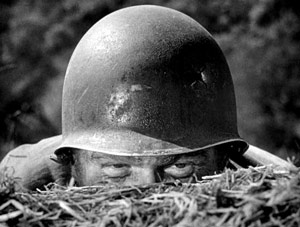 But USA must always be in one war or another (as Plato said: Only the dead have seen the end of the war), so when the Chinese decided to back communist forces in Korea, the American war machine started huffing and puffing again. At least it gave the WW2 veteran and maverick director Samuel Fuller a chance to make a couple of break through films: Fixed Bayonets! and The Steel Helmet (both 1951; notice the opening shot of that steel helmet, seemingly a piece of debris on the ground with a bullet hole in it, and then, after the credits, it begins to move and rise and we see the grizzled face of the excellent Gene Evans!). I can only say that everyone should see these! Fuller has a style and approach to psychological realism that is almost unheard of – at least in the Hollywood of the fifties. Some ten years later, he proved to be too idiosyncratic for the studio system and became an early independent film maker.
But USA must always be in one war or another (as Plato said: Only the dead have seen the end of the war), so when the Chinese decided to back communist forces in Korea, the American war machine started huffing and puffing again. At least it gave the WW2 veteran and maverick director Samuel Fuller a chance to make a couple of break through films: Fixed Bayonets! and The Steel Helmet (both 1951; notice the opening shot of that steel helmet, seemingly a piece of debris on the ground with a bullet hole in it, and then, after the credits, it begins to move and rise and we see the grizzled face of the excellent Gene Evans!). I can only say that everyone should see these! Fuller has a style and approach to psychological realism that is almost unheard of – at least in the Hollywood of the fifties. Some ten years later, he proved to be too idiosyncratic for the studio system and became an early independent film maker.
6-War as Adventure
As maybe hinted at by the audience reaction to The Red Badge of Courage, the American Public soon wanted to put the seriousness of war behind them, or maybe many hadn’t been that interested in the reality of war to begin with, so Hollywood began to work its “magic” on these films and soon they were left with little reality, but perhaps more entertainment. As Barbara Bush said, “War is not nice”, so an injection of entertainment and implausibility helped keeping it popular. Maybe the problems with validating the Korean War as an equally worthy war as WW2 also had something to do with it. (The American public was early on told that it would be a quick policing affair and scarcely a war at all. This was hardly the last time one “sold the fur before the bear had been shot”, as the Scandinavian saying a bit clumsily goes. The English-speaking part of the world can focus on counting unhatched chicken instead).
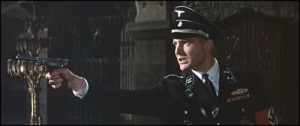 We can thank the British thriller novelist Alistair MacLean for giving us two of the best of these entertaining war films, of which the brilliant The Guns of Navarone (J. Lee Thompson, 1961) was the first adaptation of his work and Where Eagles Dare (Brian G. Hutton,1968) maybe the best in terms of pure escapism. Even though the film features stars such as Clint Eastwood and Richard Burton, I have to give a nod to Derren Nesbitt’s icy protonazi; SS-Sturmbannführer Von Hapen. Seldom have I seen a face more suited to the role! Nesbitt got his breakthrough in the WWI aviation film The Blue Max (1966), but never got any big roles after the MacLean-film.
We can thank the British thriller novelist Alistair MacLean for giving us two of the best of these entertaining war films, of which the brilliant The Guns of Navarone (J. Lee Thompson, 1961) was the first adaptation of his work and Where Eagles Dare (Brian G. Hutton,1968) maybe the best in terms of pure escapism. Even though the film features stars such as Clint Eastwood and Richard Burton, I have to give a nod to Derren Nesbitt’s icy protonazi; SS-Sturmbannführer Von Hapen. Seldom have I seen a face more suited to the role! Nesbitt got his breakthrough in the WWI aviation film The Blue Max (1966), but never got any big roles after the MacLean-film.
These films spurred literally hundreds of copies, and just 1978 sees two of the more well known of these: The sequel Force Ten From Navarone (by Bond-director Guy Hamilton, who had made The Battle of Britain in 1968) and The Wild Geese (by John Ford’s old assistant director and the man behind quite some mediocre Westerns, Andrew McLaglen) but few have come close to the originals.
 I ended up liking Von Ryan’s Express (Mark Robson, 1965) surprisingly much, seeing as it starred Frank Sinatra. It is an escape-film, but most importantly, it is the kind of action film they don’t make anymore. I was thoroughly entertained! One should also mention Kelly’s Heroes (Brian Hutton, 1970), which taught me never to look innocently on a Tiger Tank again. Not least, I must include already mentioned subversive director Robert Aldrich’s The Dirty Dozen (1967). The latter features some of the coolest actors ever (Robert Ryan, Lee Marvin, John Cassavetes, Charles Bronson, George Kennedy, Donald Sutherland (even though he hasn’t been cool since 1978), Ernest Borgnine and, well, Telly Savalas. It was a very popular film all over the world and spurred numerous copies, of which the Italian B-movie Inglorious Bastards is well known, perhaps because it is being remade by Quentin Tarantino as I write this.
I ended up liking Von Ryan’s Express (Mark Robson, 1965) surprisingly much, seeing as it starred Frank Sinatra. It is an escape-film, but most importantly, it is the kind of action film they don’t make anymore. I was thoroughly entertained! One should also mention Kelly’s Heroes (Brian Hutton, 1970), which taught me never to look innocently on a Tiger Tank again. Not least, I must include already mentioned subversive director Robert Aldrich’s The Dirty Dozen (1967). The latter features some of the coolest actors ever (Robert Ryan, Lee Marvin, John Cassavetes, Charles Bronson, George Kennedy, Donald Sutherland (even though he hasn’t been cool since 1978), Ernest Borgnine and, well, Telly Savalas. It was a very popular film all over the world and spurred numerous copies, of which the Italian B-movie Inglorious Bastards is well known, perhaps because it is being remade by Quentin Tarantino as I write this.
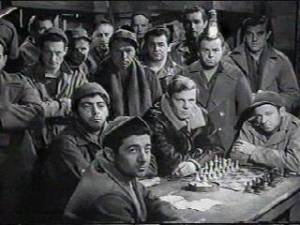 I feel that John Sturges’ POW-film The Great Escape (1963) also falls into this entertainment-category. It’s a bit of a strange film in that one sees the Germans as slightly cartoonish, but then the film turns decidedly bleaker after the eponymous escape has taken place. This seriousness is again offset by Steve McQueen’s histrionics on his motorbike, so in effect the film seems to be torn between war as realism and war as entertainment. Much of the same can also be said of the similar Stalag 17 (1953) by Billy Wilder, but this film keeps its tongue a bit more firmly in cheek and borders at times to satire. I’d like to advice most to try to see one of the better films about the war aspiring to be both entertaining and serious, namely John Frankenheimer‘s The Train, with Burt Lancaster. I particularly like Paul Scofield‘s protrayal of the German colonel, whose love of art and money bring him to desparation towards the end of the war in France.
I feel that John Sturges’ POW-film The Great Escape (1963) also falls into this entertainment-category. It’s a bit of a strange film in that one sees the Germans as slightly cartoonish, but then the film turns decidedly bleaker after the eponymous escape has taken place. This seriousness is again offset by Steve McQueen’s histrionics on his motorbike, so in effect the film seems to be torn between war as realism and war as entertainment. Much of the same can also be said of the similar Stalag 17 (1953) by Billy Wilder, but this film keeps its tongue a bit more firmly in cheek and borders at times to satire. I’d like to advice most to try to see one of the better films about the war aspiring to be both entertaining and serious, namely John Frankenheimer‘s The Train, with Burt Lancaster. I particularly like Paul Scofield‘s protrayal of the German colonel, whose love of art and money bring him to desparation towards the end of the war in France.
(EDIT: And speaking of seriousness and quality in the genre, I should definitely not forget John Boorman‘s Hell in the Pacific (1968), with Lee Marvin and Kurosawa stalwart Toshiro Mifune. The story of two enemy soldier’s finding themselves marooned on the same island is a strong intimate story between the two protagonists that serves as a kind of metonymous tract on humanity by letting their initial animosity turn into pettiness and later respect. I can’t think of two other actors I’d rather watch for an entire film! The film is funny, tragic and exciting, and while these are standard adjectives, do believe this hype! Incidentally, the film was remade in 1985 by Das Boot-director Wolfgang Petersen. Curiously it had then become a science fiction film by the name of Enemy Mine. Here Dennis Quaid‘s astronaut learns interspecies’ understanding in his meeting with Louis Gosset Jr.’s heavily made up alien soldier. It goes to show that other genres, like S/F and the Western, are often disguised war films, or allegories for ongoing conflicts. EDIT END).
7- War as Epic
The biggest war epic is a film that many perhaps don’t think of as a war film: David Lean’s excellent Lawrence of Arabia (1962). It deals with the real figure of T.E. Lawrence’s participation in the Arab revolt against the Turks in WWI. I would be hard pressed to name many better films ever made. It is a long film, but it needs to be long. The story it tells is truly epic in the sense that it deals not only with the life of a man, but with the transformation of that man into myth. However, from the sixties onward, many films dealing with war evidently needed to be very long films, while not always convincing me that this need sprung from the material itself. This is still true today, where it is seldom that a war film clocks in under the two hour mark.
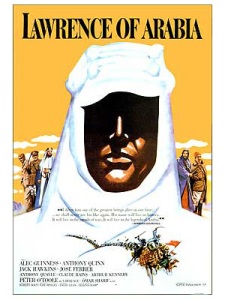 The aptly named The Longest Day (also from 1962), starring every actor on the planet, is a three hour epic about the Normandy Invasion. It is told from the point of view of both sides of the conflict and is a solid, if not extraordinary film. A Bridge Too Far (1977) also goes on for three hours and has some splendid scenes, but as a film I feel it struggles to tell a coherent story. It wants to throw in any skirmish it can find and give cameos to as many known faces as possible. Anthony Hopkins’s character’s story seems worth following. Some images of his defence of the bridge – is it at Arnhem? (my memory fails me, as I’ve only seen the film once) – are truly memorable.
The aptly named The Longest Day (also from 1962), starring every actor on the planet, is a three hour epic about the Normandy Invasion. It is told from the point of view of both sides of the conflict and is a solid, if not extraordinary film. A Bridge Too Far (1977) also goes on for three hours and has some splendid scenes, but as a film I feel it struggles to tell a coherent story. It wants to throw in any skirmish it can find and give cameos to as many known faces as possible. Anthony Hopkins’s character’s story seems worth following. Some images of his defence of the bridge – is it at Arnhem? (my memory fails me, as I’ve only seen the film once) – are truly memorable.
Zulu (1964) is also well past the two hour mark, but in this case I feel all the minutes are put to worthwhile use. This is an English film, with a very young Michael Caine, about a 4000 men strong Zulu attack on a field hospital defended by 139 British soldiers. The sound of the approaching Zulus stays with you! While it is these days difficult to feel sympathy for the British imperialists, the film is successful in that we come to admire this as one of the real historical “last stands”. Without this film, there would be no “battle of Helm’s Deep” in the Second of The Lord of the Rings-trilogy (The Two Towers). And, while we are celebrating British imperialism, I have to give a shout out to Henry Hathaway’s adventure film The Lives of a Bengal Lancer (1935), which I thought almost shockingly good compared to many other contemporary films in this genre. I think it’s safe to say that Steven Spielberg watched this film prior to the first Indiana Jones-film. Stunts and war scenes are of a nature that I think most unions would forbid today. While the belief that the British were saviours to India and the – for the period – usual racist portrayals can seem jarring to modern sensibilities, there is actually much here to admire in terms of storytelling and a layered, and possibly subversive, plot. The film is about the British military fighting local war lords on the border to Afghanistan and, again, one can muse how little the world has changed. I can’t remember having seen many better films this year and actually want to rewatch it as I write this.
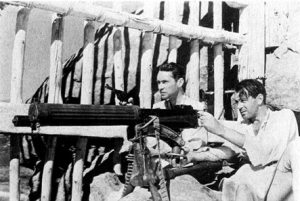 Viet Nam should have its own section here, but since I assume that most are familiar with these films anyhow, I’ll include them under the “epic” banner. Robert Wise’s The Sand Pebbles (1966) is not about Viet Nam per se, but clearly at least allegorically linked. While not an unmitigated success, the film is often good and intermittently very good. Apocalypse Now (Francis Ford Coppola, 1979) lasts 153 American minutes and is deservedly a modern classic. The recently released Redux-version goes on for 202 minutes and, while adding some background for the characters and their actions, also takes some of the immediacy and momentum away from the film. The Deer Hunter (Michael Cimino, 1978) is a good three hours and when I saw it again for about the fifth time recently, I felt it wasn’t quite as good as I once thought it was. It contains some exceptional scenes, but I’m not sure I like what the film is actually saying. Its view of America seems especially half-assed. The sentimentalization of small town values could have come from the mouth of Sarah Palin, and likewise some of the patriotism. Another film about Viet Nam was Go Tell the Spartans (1978), with Burt Lancaster, about the war prior to the bulk of US involvement.
Viet Nam should have its own section here, but since I assume that most are familiar with these films anyhow, I’ll include them under the “epic” banner. Robert Wise’s The Sand Pebbles (1966) is not about Viet Nam per se, but clearly at least allegorically linked. While not an unmitigated success, the film is often good and intermittently very good. Apocalypse Now (Francis Ford Coppola, 1979) lasts 153 American minutes and is deservedly a modern classic. The recently released Redux-version goes on for 202 minutes and, while adding some background for the characters and their actions, also takes some of the immediacy and momentum away from the film. The Deer Hunter (Michael Cimino, 1978) is a good three hours and when I saw it again for about the fifth time recently, I felt it wasn’t quite as good as I once thought it was. It contains some exceptional scenes, but I’m not sure I like what the film is actually saying. Its view of America seems especially half-assed. The sentimentalization of small town values could have come from the mouth of Sarah Palin, and likewise some of the patriotism. Another film about Viet Nam was Go Tell the Spartans (1978), with Burt Lancaster, about the war prior to the bulk of US involvement.
By far my favourite of these epic films of the sixties and seventies is Franklin J. Schaeffner’s Patton (1970). Apart from letting us follow the great, but maybe not good, man through his worst and best times, the film also manages to say something about the nature of war and how it is mythologized. There are countless excellent scenes showing how Patton himself is obsessed with this self-mythologization, and I feel the film gives us a balanced and psychologically sound portrayal of the old warrior. The music by Jerry Goldsmith, in which he could “militarize” some of his ideas for Planet of the Apes (also directed by Schaeffner), which he had scored two years prior, is excellent and is so endemic to the war genre that it has been alluded to in almost all portrayals of the military thereafter, even finding its way into some episodes of the Simpsons. The staccato bugle is the sound of war from the first ever waged between warring tribes heralding their approach to the last anyone will ever die to see. Tellingly, Goldsmith’s score for First Blood, the first and best Rambo-film, also references his own earlier work. The short bursts of that signature trumpet line gives me goose bumps every time!
Patton is an example of The War Biopic, portrayals of real protagonists of real wars. It is almost a genre on its own, but doesn’t yet contain enough examples of quality, though there are some. Already in 1951, Henry Hathaway made The Desert Fox, about the latter days of one of the few admired German soldiers of WW2, Field Marshal Erwin Rommel. James Mason did such a good role that he was called to repeat it two years later in Robert Wise’s The Desert Rats, about British soldiers, led by Richard Burton, trying to survive Rommel’s tactics. I feel that only the first film is truly good, not least because of some heart breaking scenes towards the end when Hitler has decided upon Rommel’s participation in the plot to kill him. A later example of the war biopic is MacArthur (1977), where Gregory Peck portrays the General as maybe too sympathetic. Peck also played the original Doctor Death, Josef Mengele, in The Boys From Brazil, but I don’t feel this is a war film even though it deals with Nazis. The same is true of John Schlesinger‘s Marathon Man (1976). It is about nazis, led by the dentist version of Mengele, Doctor Christian Szell, played by Laurence Olivier, hunting Dustin Hoffman in New York in the 70s.
 Another sympathetic portrayal of the Germans with James Mason in a leading role is Sam Peckinpah’s Cross of Iron (1977), which shows the Russian front from the point of view of the German soldiers. I wish James Coburn had gotten more juicy roles like his Captain Steiner in this film. I’m glad Peckinpah was able to make the film, even though he had to finance it with the money from a German Porn producer and was reportedly drinking four bottles of vodka/whisky every day during the filming. He never made a good film again. Maximilian Schell, who plays Steiner’s cowardly rival, was at the time still mostly known for his role as a defence lawyer for the German war criminals in Stanley Kramer’s solid “message movie” Judgment at Nuremberg (1961). He also had a role in the so-so wannabe epic The Young Lions (Edward Dmytryk,1958), in which we have the pleasure of hearing Marlon Brando speak English with an accent that is meant to be German. The Young Lions is mostly marred, though, by another Judgment at Nuremberg-actor, Montgomery Clift, whose eccentric portrayal of a character that is meant to be pretty normal rings false in many scenes. The strange effect, though, is that these scenes also become the most interesting. This film was among the first to show the liberation of the concentration camps, but doesn’t manage to convey the horror to the extent that Alain Resnais‘ short (and anti-epic) masterpiece Night and Fog (1955) does.
Another sympathetic portrayal of the Germans with James Mason in a leading role is Sam Peckinpah’s Cross of Iron (1977), which shows the Russian front from the point of view of the German soldiers. I wish James Coburn had gotten more juicy roles like his Captain Steiner in this film. I’m glad Peckinpah was able to make the film, even though he had to finance it with the money from a German Porn producer and was reportedly drinking four bottles of vodka/whisky every day during the filming. He never made a good film again. Maximilian Schell, who plays Steiner’s cowardly rival, was at the time still mostly known for his role as a defence lawyer for the German war criminals in Stanley Kramer’s solid “message movie” Judgment at Nuremberg (1961). He also had a role in the so-so wannabe epic The Young Lions (Edward Dmytryk,1958), in which we have the pleasure of hearing Marlon Brando speak English with an accent that is meant to be German. The Young Lions is mostly marred, though, by another Judgment at Nuremberg-actor, Montgomery Clift, whose eccentric portrayal of a character that is meant to be pretty normal rings false in many scenes. The strange effect, though, is that these scenes also become the most interesting. This film was among the first to show the liberation of the concentration camps, but doesn’t manage to convey the horror to the extent that Alain Resnais‘ short (and anti-epic) masterpiece Night and Fog (1955) does.
Now, I am sure that I have forgotten many films that someone out there feels should be included in this list. If some omissions are too glaring, let me know! I’ll soon come back with a shorter post about Asian and modern war films. “Our present business is general woe”, are we informed in King Lear. This is as fine a general description of the subject matter as we can hope for. Epictetus, one of my favourite stoics, calls Man “a pure soul burdened with a corpse”. I’ll venture, though, that if the films mentioned above have not helped us to avoid the proliferation of war in our age, they have at least made the burden recognizable and thus, perhaps, easier to bear.
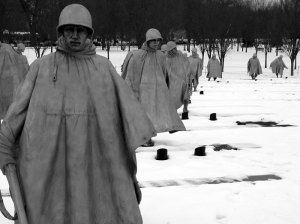
 Unlike some biographies, in this case, I think you definitely have to be a fan to enjoy the book. I’ve read autobiographies by John Huston, Roman Polanski and Samuel Fuller that were all so well written and downright exciting, that the reader could enjoy them cold. For one thing a biography is not an autobiography, so the genius of the protagonist is not necessarily reflected in the tale. Jarlett’s biography of Ryan is sturdy and solid, but lacks perhaps some spark or reason to read for the non-Ryanist. The book is also split in two, where the first half is the biography, and the second part is a “critical filmography”. This latter part is very handy for scholarly purposes, but also for the above average Ryan-fan. All his films are included, with full technical specifications (cast list, company, year, producer, screenplay, etc.), followed by abstracts of contemporary reviews of the film in question.
Unlike some biographies, in this case, I think you definitely have to be a fan to enjoy the book. I’ve read autobiographies by John Huston, Roman Polanski and Samuel Fuller that were all so well written and downright exciting, that the reader could enjoy them cold. For one thing a biography is not an autobiography, so the genius of the protagonist is not necessarily reflected in the tale. Jarlett’s biography of Ryan is sturdy and solid, but lacks perhaps some spark or reason to read for the non-Ryanist. The book is also split in two, where the first half is the biography, and the second part is a “critical filmography”. This latter part is very handy for scholarly purposes, but also for the above average Ryan-fan. All his films are included, with full technical specifications (cast list, company, year, producer, screenplay, etc.), followed by abstracts of contemporary reviews of the film in question. Jarlett’s language is not particularly adventurous, but serves its purpose. I am, however, left with a feeling that there should be more to this tale, and all biographies are indeed tales. For one thing, the characters never really come to life under Jarlett’s pen. Just because one is writing about real persons, doesn’t mean that the text magically will transform them into full-bodied specimen on the page. There is enough here, though, to mourn both Ryan’s lack of roles and his premature death of cancer at the age of 63. Jarlett seems to have talked to all the relevant players and I guess that this is the only Ryan biography we will ever see, as many of the interviewees have since died, such as John Frankenheimer. (The book is from 1990). And I have to compliment Jarlett for having both the inclination and the stamina to write this book, as I can’t think of a single movie star more deserving of a biography and critical filmography than Robert Ryan. If you are a fan, you should definately read this biography.
Jarlett’s language is not particularly adventurous, but serves its purpose. I am, however, left with a feeling that there should be more to this tale, and all biographies are indeed tales. For one thing, the characters never really come to life under Jarlett’s pen. Just because one is writing about real persons, doesn’t mean that the text magically will transform them into full-bodied specimen on the page. There is enough here, though, to mourn both Ryan’s lack of roles and his premature death of cancer at the age of 63. Jarlett seems to have talked to all the relevant players and I guess that this is the only Ryan biography we will ever see, as many of the interviewees have since died, such as John Frankenheimer. (The book is from 1990). And I have to compliment Jarlett for having both the inclination and the stamina to write this book, as I can’t think of a single movie star more deserving of a biography and critical filmography than Robert Ryan. If you are a fan, you should definately read this biography.











 Alfred Hitchcock
Alfred Hitchcock




 Sam Wood
Sam Wood









